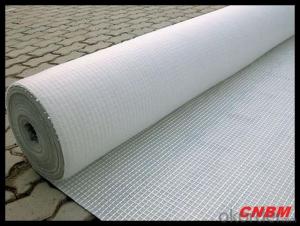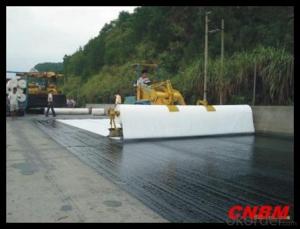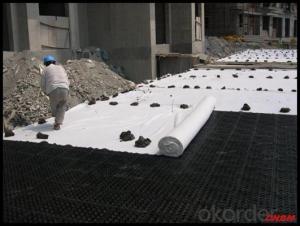Geotextile Road Building Constructive Felt Fabric
- Loading Port:
- China main port
- Payment Terms:
- TT OR LC
- Min Order Qty:
- 1000 g/m²
- Supply Capability:
- 10000000 g/m²/month
OKorder Service Pledge
OKorder Financial Service
You Might Also Like
Item specifice
Primary Competitive Advantages:
Country of Origin
Experienced Staff
Form A
Guarantee/Warranty
International Approvals
Packaging
Price
Product Features
Product Performance
Prompt Delivery
Reputation
Service
Main Export Markets:
Asia
Australasia
Central/South America
Eastern Europe
Mid East/Africa
North America
Western Europe

FAQ:
Q: What kind of payments does jenor support?
A: T/T, L/C, Cash are accepted.
Q: Do you charge for the samples?
A: Accordeing to our company policy, the samples are free, we only charge the freight fee. And we will return the freight fee during the next order.
Q: Can you produce according to customers' design?
A: Sure, we are professional manufacturer, OEM and ODM are both welcome.
Q: Do you have other products?
A: Yes, please check the pictures:
Quality assurance
1.On a regular basis or as per your request,we entrust national testing agencies to conduct quality inspections
2. Strictly in accordance with the ISO9001-2008 international quality system standard,we monitor and manage the whole process throughout production,quality testing,and measurement to ensure product quality
3. For quality-related construction delay or substandard construction(except for damage or losses due to customer’s responsibility or irresistible natural disasters),we have refunding,replacement,and repair services.We will respond to customers’ feedbacks on quality issues within 24 hours.
Packaging & Shipping
Packing: PLASTIC FILM INSIDE, AND WOVEN BAG OUTSIDE
Shipping: About 15 days after receipt the deposit
- Q:How do geotextiles help in preventing the loss of aggregate in unpaved roads?
- Geotextiles help in preventing the loss of aggregate in unpaved roads by acting as a barrier between the road surface and the underlying soil. They provide a stable and durable layer that prevents the aggregate from being displaced or eroded by the forces of traffic, water, and wind. This helps to maintain the integrity of the road and reduce maintenance costs.
- Q:Can geotextiles be used in geocomposite drains?
- Yes, geotextiles can be used in geocomposite drains. Geocomposite drains typically consist of a geotextile fabric wrapped around a core material, such as a perforated pipe. The geotextile helps to filter and separate fine particles from the core material, preventing clogging and enhancing drainage efficiency.
- Q:How are geotextiles used in geotechnical engineering?
- Geotextiles are used in geotechnical engineering to enhance soil stability, drainage, filtration, and erosion control. They are commonly used as reinforcement layers in road construction, embankments, retaining walls, and landfills. Geotextiles improve the overall performance and longevity of geotechnical structures by providing separation, filtration, and reinforcement functions.
- Q:Geotextile with ordinary non-woven like not? The
- Geotextiles are warp.
- Q:What are the environmental considerations of geotextiles?
- Geotextiles have several environmental considerations, both positive and negative. On the positive side, geotextiles can help prevent soil erosion, reduce sedimentation in water bodies, and improve the stability of slopes and embankments, ultimately leading to the preservation of natural habitats. Additionally, geotextiles are often made from recycled materials, such as plastic bottles, which can help reduce waste and promote sustainability. However, there are also potential negative environmental impacts associated with geotextiles. The production and disposal of geotextiles can contribute to pollution, particularly if non-recycled materials are used. Additionally, if not properly installed or maintained, geotextiles can cause unintended consequences, such as altering natural drainage patterns or obstructing the movement of wildlife. Therefore, it is important to carefully assess the environmental implications of using geotextiles and ensure proper installation, maintenance, and disposal practices to mitigate any potential negative impacts.
- Q:How do geotextiles prevent soil erosion on slopes?
- Geotextiles prevent soil erosion on slopes by providing a protective barrier that stabilizes the soil and prevents it from being washed away by water runoff. They help to distribute the weight of rainfall evenly across the slope, reducing the erosive force and promoting water infiltration into the soil. Additionally, geotextiles retain sediment particles, preventing their movement and maintaining the integrity of the slope.
- Q:What are the advantages of using geotextiles in wetland restoration projects?
- There are several advantages of using geotextiles in wetland restoration projects. Firstly, geotextiles provide effective erosion control by stabilizing the soil and preventing it from washing away during heavy rainfall or flooding. This helps in maintaining the wetland's structure and preventing further degradation. Secondly, geotextiles act as a barrier, preventing the migration of harmful substances such as pollutants or excess nutrients from adjacent areas into the wetland, thus protecting its ecological integrity. Additionally, geotextiles can enhance vegetation growth by retaining moisture in the soil, promoting root development, and preventing weed growth. This ultimately contributes to the overall success of wetland restoration efforts.
- Q:How do geotextiles help in preventing the migration of fine particles in soils?
- Geotextiles help in preventing the migration of fine particles in soils by acting as a barrier or filter. These textile materials are designed to have a high permeability, allowing water to flow through while retaining the fine particles within the soil. This prevents erosion and the movement of soil particles, thereby stabilizing the soil structure and preventing soil degradation.
- Q:Do you have a geotextile
- Summer to sunscreen, winter to antifreeze. The So summer not only to be able to block the sun, but also breathable. The Winter to warm good. The To achieve such a request, no matter what you can make the material. The
- Q:What is the difference between polypropylene geotextile, polypropylene geotextile and polyester geotextile
- Material is not the same
1. Manufacturer Overview |
|
|---|---|
| Location | |
| Year Established | |
| Annual Output Value | |
| Main Markets | |
| Company Certifications | |
2. Manufacturer Certificates |
|
|---|---|
| a) Certification Name | |
| Range | |
| Reference | |
| Validity Period | |
3. Manufacturer Capability |
|
|---|---|
| a)Trade Capacity | |
| Nearest Port | |
| Export Percentage | |
| No.of Employees in Trade Department | |
| Language Spoken: | |
| b)Factory Information | |
| Factory Size: | |
| No. of Production Lines | |
| Contract Manufacturing | |
| Product Price Range | |
Send your message to us
Geotextile Road Building Constructive Felt Fabric
- Loading Port:
- China main port
- Payment Terms:
- TT OR LC
- Min Order Qty:
- 1000 g/m²
- Supply Capability:
- 10000000 g/m²/month
OKorder Service Pledge
OKorder Financial Service
Similar products
New products
Hot products
Hot Searches
Related keywords
































